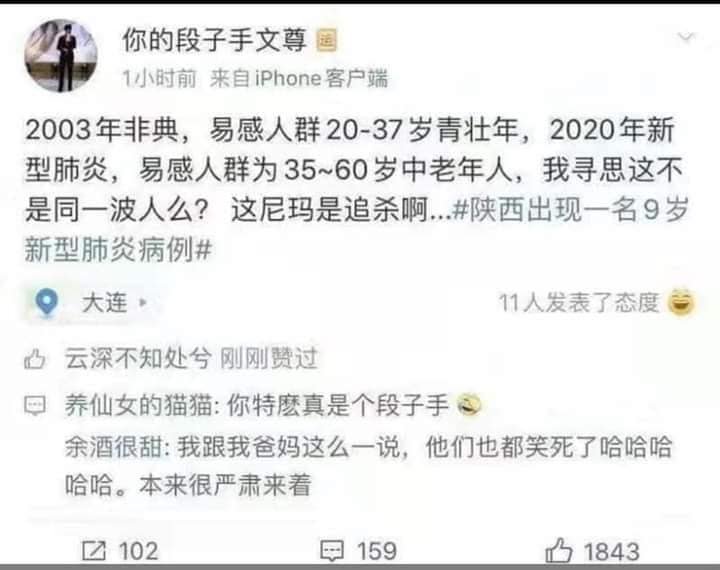Mô tả hai ca bệnh tại bệnh viện chợ Rẫy trên NEJM.
Importation and Human-to-Human Transmission of a Novel Coronavirus in Vietnam
January 28, 2020
DOI: 10.1056/NEJMc2001272
Metrics
TO THE EDITOR:
The emergence and spread of a novel coronavirus (2019-nCoV) from Wuhan, China, has become a global health concern.1 Since the detection of the coronavirus in late December 2019, several countries have reported sporadic imported cases among travelers returning from China.2 We report one family cluster of 2019-nCoV originating from a Chinese man.
On January 22, 2020, a 65-year-old man with a history of hypertension, type 2 diabetes, coronary heart disease for which a stent had been implanted, and lung cancer was admitted to the emergency department of Cho Ray Hospital, the referral hospital in Ho Chi Minh City, for low-grade fever and fatigue. He had become ill with fever on January 17, a total of 4 days after he and his wife had flown to Hanoi from the Wuchang district in Wuhan, where outbreaks of 2019-nCoV were occurring. He reported that he had not been exposed to a “wet market”(a market where dead and live animals are sold) in Wuhan.
Figure 1.
Radiographs of the Father’s Chest.
Throat swabs obtained from the patient tested positive for 2019-nCoV on real-time reverse-transcription–polymerase-chain-reaction (RT-PCR) assays.3 On admission to the hospital, the man was isolated and treated empirically with antiviral agents, broad-spectrum antibiotics, and supportive therapies. Chest radiographs obtained on admission showed an infiltrate in the upper lobe of the left lung (Figure 1A). On January 25, he received supplemental oxygen through a nasal cannula at a rate of 5 liters per minute because of increasing dyspnea with hypoxemia. The partial pressure of oxygen was 57.2 mm Hg while he was breathing ambient air, and a progressive infiltrate and consolidation were observed on chest radiographs (Figure 1B through 1D). His fever disappeared on January 25, and his clinical condition has improved since January 26. His wife had no symptoms of illness while they were traveling. She was healthy as of January 28.
The couple’s healthy 27-year-old son had lived in Long An, a province 40 km southwest of Ho Chi Minh City, since October 2019. He had not traveled to a region where 2019-nCoV was spreading, and he had not had any known contact with any person returning from such a region. On January 17, he met his father in Nha Trang in central Vietnam and shared a bedroom with his parents for 3 days in a hotel room that had an air conditioner. On January 20, a dry cough and fever developed in the son. He also reported having had vomiting and loose stools one time before the admission. This suggests that the incubation period for 2019-nCoV may have been 3 days or less in this case. When the son presented at Cho Ray Hospital with his father on January 22, his illness, characterized by a fever (39°C), was recognized and he was immediately isolated. Chest radiographs and other laboratory examinations in this patient showed no abnormalities except for an increased level of C-reactive protein (13.9 mg per liter). Real-time RT-PCR assays for influenza A and B viruses and nonstructural protein 1 antigen rapid tests for dengue viruses were negative in both the father and son. A throat swab in the son was positive for 2019-nCoV. His father was thought to be the source of infection. However, sequencing of strains from the two patients to ascertain the transmission of 2019-nCoV from the father to son has not been performed. The son’s condition was stable after January 23.
This family had traveled to four cities across Vietnam using various forms of transportation, including planes, trains, and taxis.
A total of 28 close contacts have been identified, and symptoms of an upper respiratory infection have not developed in any of them. This family cluster of 2019-nCoV infection that occurred outside China4 arouses concern regarding human-to-human transmission.
Nghiên cứu tại Úc nói virus biến thể CoV lây sau 15 phút nói chuyện bình thường, và 5 phút nếu tiếp xúc gần trong không gian kín. Còn VN thì kết luận như trên, các cụ mợ ngành y cần nghiêm túc đánh giá lại kết luận của mình. Close contact là gặp nhau trong bao lâu, nói chuyện trong không gian nào? Virus nó biến chuyển rất nhanh, hiện đã có chủng 2, chủng 3 CoV rồi ạ.










